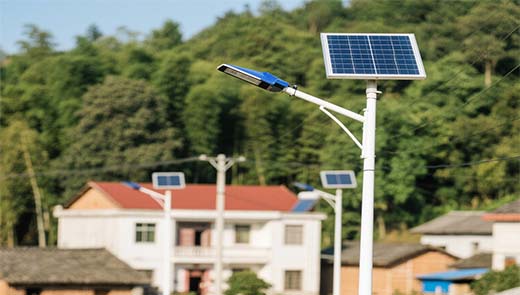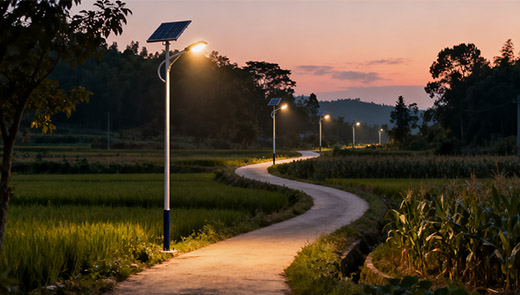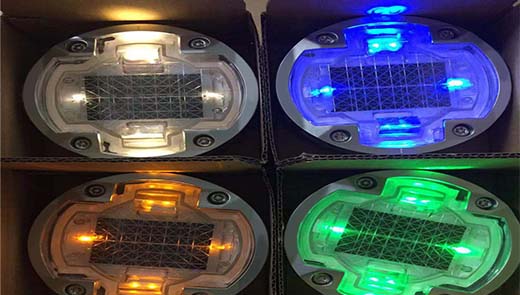Rural roads to choose how high power street lights?
In the rural revitalization strategy to promote the process of rural road lighting project has become an important initiative to improve the travel environment of villagers and enhance the safety index of the countryside. However, many villages in the procurement of street lights will face a core problem: rural roads to choose how high power street lights are appropriate? Choose a small brightness is not enough, night travel is still a security risk, choose a large not only increase the procurement cost, but also cause a waste of electricity, and may even affect the villagers due to glare rest. This article combines the actual scene of rural roads, lighting needs and energy saving requirements, for you to explain in detail the power of the street lamp selection points, to help you choose the most cost-effective products.
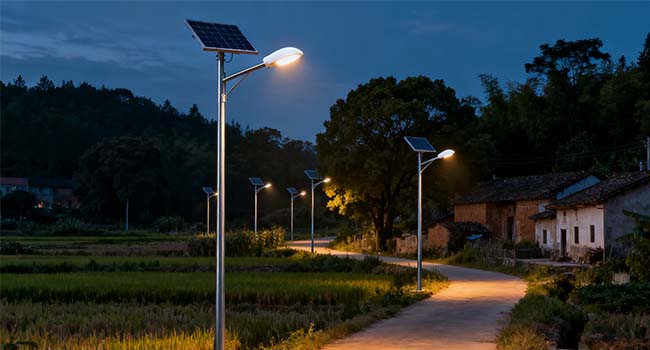
Difference in street light demand between rural roads and city roads
To choose the right street light power, first of all, we must recognize the uniqueness of rural roads -- compared with the city's main roads, secondary roads, rural roads in the traffic flow, traffic flow, the width of the road there is a clear difference, which directly determines the power of the street light does not need to be blindly standardized to the city.
Lower traffic and pedestrian flow
The main body of the rural road traffic to the villagers daily use of small private cars, electric tricycles, bicycles and pedestrians, very few city roads peak traffic, large trucks and intensive traffic. And less night activities in the countryside, after 8 p.m. road traffic will drop dramatically, no need to use high intensity lighting to meet the demand for long-distance vision of high-speed traffic, like urban street lights, low-power lighting can ensure basic safety.
Narrower road width
The width of urban main roads is generally more than 10 meters, and some expressways are even more than 20 meters, requiring high-power street lights to cover wide road surfaces; while most rural main roads are only 3-6 meters wide, and the feeder roads used to connect villages or neighboring villages are even narrower, or even less than 3 meters wide. This narrow road surface characteristics, so that the street lights do not need to be too large lighting coverage, small power lights and lanterns can achieve full road surface coverage.
Limited power supply conditions
The urban power grid has been improved for a long time, with high stability of power supply, which can easily carry the power demand of high-power street lights; however, the power grid construction in some remote villages is relatively weak, with voltage fluctuations and limited power supply capacity. If the installation of high power street lights, not only may exceed the local circuit load, resulting in tripping, line heating and other safety hazards, but also due to high power consumption to increase the village collectively or the villagers of the long-term expenditure on electricity, aggravating the economic burden.
Complex installation environment
City street lights are mostly installed in the sidewalk or green belt next to the hardened road, the surrounding environment is relatively clean and dry; while the rural roads are mostly built along the farmland, woodland, river, humid and rainy in the summer, mosquitoes gather, dusty fields in the spring and fall, and low-temperature frosts may occur in the winter. This requires street lights with better anti-mosquito, anti-humidity, dust proof performance, power selection also needs to be matched with the protection level of the lights, to avoid frequent failure of high-power lights due to heat dissipation, protection problems.
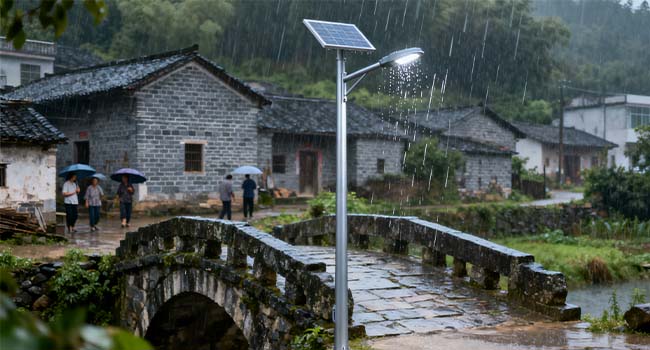
Influence factors on the power selection of rural road street lights
Road width
Road width is the primary basis for the power selection of street lights, different widths of the road on the light coverage and brightness of the requirements of the significant differences:
Narrow road (1-3 meters): such as countryside alleys, field trails, no need for high-power lighting, usually choose 10-30W LED street lights can be, the radius of light can cover both sides of the road, to avoid the emergence of lighting dead ends.
Conventional main road (3-6 meters): such as the main road connecting villages and townships, need to take into account the safety of pedestrians and vehicular traffic, it is recommended to choose 30-60W LED street lights, the brightness of which can reach 200-500 lumen, which can ensure the road surface is clear, and will not be affected by the glare impact on driving.
Wide road (more than 6 meters): such as part of the countryside of the industrial park roads, tourist attractions, roads, can choose 60-100W LED street lights, or “double side symmetrical installation” way, with lower power to achieve full coverage, to avoid the uneven illumination caused by the single side of the high power.
Installation spacing
Street lights are not the better the more power they have. If installed too close together, high power street lights will result in overlapping light and wasted power. If the spacing is too far, low-power street lights will appear “dark zone”. Usually, the installation spacing of rural road street lights is 20-50 meters, and the power can be matched according to the following principles:
Spacing 20-30 meters: choose 30-50W street lights, single-lamp coverage can be connected with adjacent street lights, no obvious dark areas.
Spacing 30-50 meters: choose 50-80W street lights to ensure that the radius of illumination reaches 15-25 meters, avoiding insufficient illumination due to large spacing.
Functional requirements
In addition to basic lighting, some rural roads may have special needs, and the power needs to be adjusted according to the scene:
Safety priority areas: such as village entrances, near schools, crossroads, need to enhance the brightness to ensure safety, you can choose 60-80W street lights, or with the “human body sensing function”, usually use 30W low-power energy-saving, people and vehicles pass automatically switch to high power.
Energy-saving priority areas: such as remote villages, solar-powered roads, it is recommended to choose 30-50W solar-powered LED street lights, taking into account the brightness and range, to avoid the solar panel power supply is insufficient due to high power, affecting the night lighting.
Landscape supporting areas: such as rural tourism roads, cultural squares around, you can choose 30-60W “warm light LED street light” (color temperature 3000K-4000K), not only to meet the lighting needs, but also to create a warm atmosphere of the countryside at night, to avoid the destruction of the environment of the mood of the cold white light.
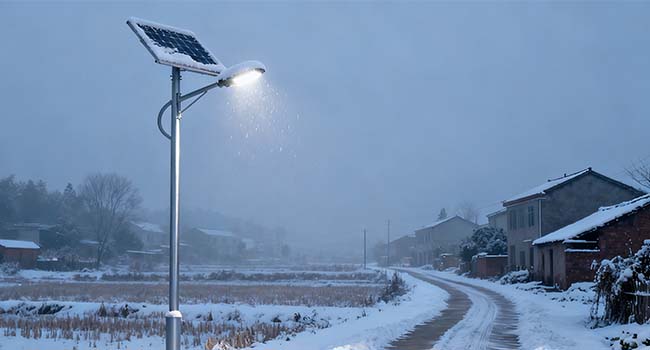
Avoiding pits in the purchase of rural street lights
After choosing the right power, if you ignore the following details, it may still lead to poor experience of using the street light. It is recommended to pay attention to the following details when purchasing:
Brightness ≠ power
Some merchants will falsely label the power in order to attract customers, such as the actual 40W LED street light labeled as “60W”, which seems to be cost-effective, but the actual lighting effect is greatly reduced. Selection can not only look at the power value, we must ask the business to provide a third-party test report, focusing on viewing the “actual lumen value” - high-quality LED street lights 1W corresponding to the lumen value should be ≥ 80lm, such as 60W street lights need to reach the value of lumen 4800lm The lumen value of 60W street light should reach 4800lm.
If there is no test report, can be tested on-site, light up the street lamp in a dark environment, 5 meters away from the newspaper text can be clearly seen, and no obvious uneven light spots, is considered to be the brightness of the qualified, to avoid the false labeling of power leads to the follow-up of insufficient lighting.
Protection level to meet the standard
Rural road environment is special, summer rain, spring fog, mosquitoes in the fall, if the street lamp protection level is insufficient, it is very easy to short-circuit, rust, lamp bead damage and other problems. When choosing the street light, you need to make sure that the protection level of the street light reaches IP65 or above, in which the first digit “6” after “IP” stands for complete dust proof, which can prevent the dust from entering into the light body in the field. The second digit “5” on behalf of anti-rainstorm, can cope with sudden heavy rainfall in the countryside.
At the same time, the lamp beads should be selected with high color rendering (Ra ≥ 70), for example, when irradiating crops or pedestrians at night, it can accurately present the original color of the object, avoiding the poor color rendering leading to pedestrians not being able to see the obstacles on the road or drivers misjudging the road conditions.
Give priority to the intelligent control model
There are obvious time differences in the traffic volume of rural roads at night, for example, villagers travel more before 20 o'clock, and there are basically no pedestrians and vehicles after 23 o'clock. If you choose ordinary fixed-power street lights, they will still run at high power late at night, resulting in a large amount of wasted power. When the budget allows, it is recommended to choose intelligent street lights with light sensing, time control or human body sensing.
The light-sensing function can automatically turn on and off the light according to the sky color, avoiding manual operation errors. The time control function can be set to automatically reduce the power to half power late at night (e.g. 23:00 - 5:00 a.m.), such as 60W street light down to 30W, while the human body sensing model can automatically increase the power when detecting pedestrians and vehicles, and return to a low power when no one is there.
Rural road street light power selection without blind pursuit of high power, the key is to combine the road width, installation spacing and the actual functional needs of accurate matching, while paying attention to the authenticity of the brightness, level of protection and intelligent control functions. Reasonable selection not only to protect the safety of night travel, but also to control costs, reduce waste, for the countryside lighting project really play a long-lasting role.

